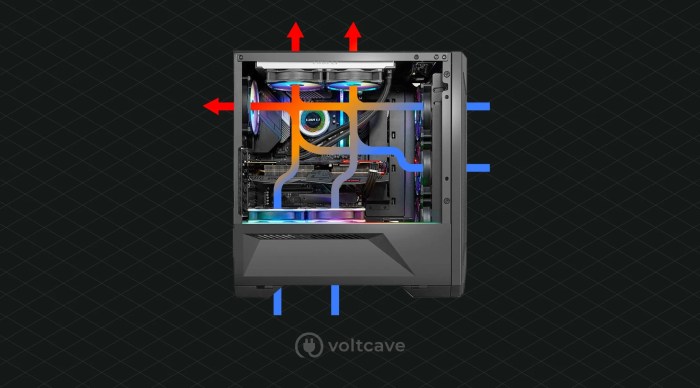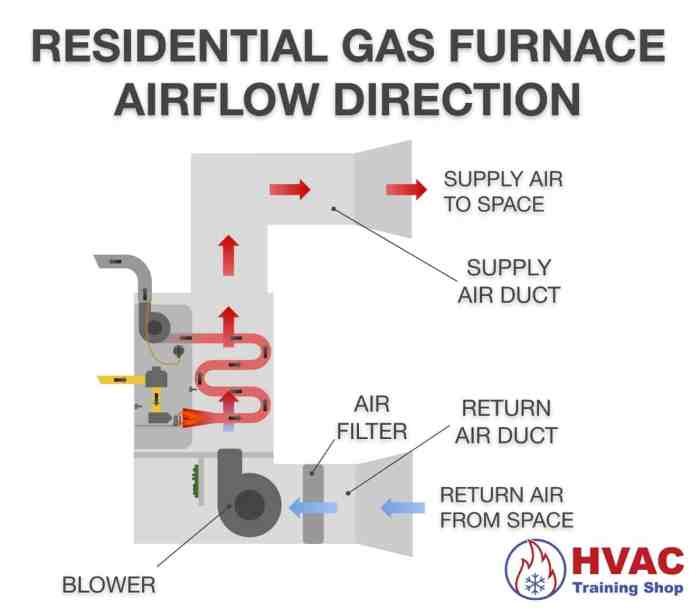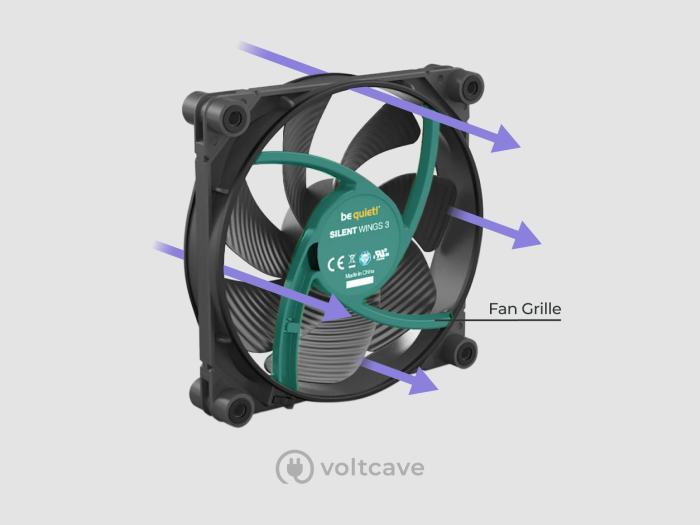What is the airflow direction in a CACI? This comprehensive guide delves into the intricacies of airflow patterns, measurement techniques, optimization strategies, and performance implications within Computer Aided Costing Implementation (CACI) systems. Understanding airflow direction is crucial for ensuring optimal CACI operation, maximizing cooling efficiency, and minimizing energy consumption.
Airflow patterns in CACIs vary based on model and configuration. Factors such as fan placement, ductwork design, and room layout influence airflow direction. Accurate airflow measurement using anemometers or other instruments is essential for optimizing CACI performance. Common airflow problems can arise, but strategies exist to optimize airflow direction and improve CACI efficiency.
Airflow Patterns

Airflow patterns in a CACI (computer air conditioning unit) are crucial for ensuring optimal cooling and energy efficiency. The typical airflow direction is from the front of the unit, where the air intake is located, to the back, where the exhaust is situated.
This allows the CACI to draw in cool air, pass it over the internal components to remove heat, and then expel the warm air outside.However, airflow patterns can vary depending on the specific CACI model and configuration. For example, some units may have multiple air intakes or exhausts, or the fan placement may be different.
Additionally, the room layout and the presence of obstacles can also affect airflow direction.
Factors Influencing Airflow Direction, What is the airflow direction in a caci
Several factors influence airflow direction in a CACI, including:
- Fan placement:The location and orientation of the fans within the CACI can significantly impact airflow patterns. Fans can be positioned to create a focused stream of air or a more diffuse flow.
- Ductwork design:The design of the ductwork, including the size, shape, and routing, can affect the airflow direction and velocity.
- Room layout:The size, shape, and layout of the room where the CACI is installed can influence airflow patterns. Obstacles, such as furniture or equipment, can disrupt airflow and create dead spots.
Airflow Measurement

Accurate measurement of airflow direction is essential for ensuring proper CACI operation. Several methods can be used to measure airflow direction, including:
- Anemometers:Anemometers are handheld devices that measure air velocity and direction. They can be used to map airflow patterns in a CACI and identify areas where airflow is obstructed or insufficient.
- Smoke tubes:Smoke tubes are devices that emit a thin stream of smoke. The direction of the smoke can be used to visualize airflow patterns and identify areas of turbulence or recirculation.
Airflow Optimization

Optimizing airflow direction can improve CACI performance and efficiency. Common airflow problems that can occur in CACIs include:
- Recirculation:Recirculation occurs when warm air from the exhaust is drawn back into the air intake. This can reduce the cooling capacity of the CACI and increase energy consumption.
- Dead spots:Dead spots are areas where airflow is stagnant or insufficient. These can lead to uneven cooling and discomfort for occupants.
- Turbulence:Turbulence occurs when airflow is disrupted by obstacles or changes in ductwork. This can create noise and reduce the efficiency of the CACI.
Strategies for Optimizing Airflow Direction
Several strategies can be employed to optimize airflow direction in a CACI, including:
- Proper fan placement:Fans should be positioned to create a focused stream of air that covers the entire cooling area.
- Optimized ductwork design:Ductwork should be designed to minimize pressure drop and ensure smooth airflow.
- Strategic placement of obstacles:Obstacles, such as furniture or equipment, should be placed in a way that minimizes disruption to airflow.
- Use of airflow modeling tools:Airflow modeling tools can be used to simulate airflow patterns and identify areas where airflow can be improved.
Airflow Impact on CACI Performance: What Is The Airflow Direction In A Caci
Airflow direction can significantly impact the performance of a CACI. Factors such as cooling capacity, energy consumption, and noise levels can all be affected by airflow patterns.
- Cooling capacity:Proper airflow direction ensures that the CACI can effectively remove heat from the cooled space. Insufficient or obstructed airflow can reduce the cooling capacity of the unit.
- Energy consumption:Optimized airflow direction can reduce energy consumption by ensuring that the CACI operates efficiently. Recirculation and turbulence can increase energy consumption by forcing the CACI to work harder.
- Noise levels:Turbulence and other airflow problems can create noise. Optimizing airflow direction can reduce noise levels and improve occupant comfort.
FAQ Compilation
What is the typical airflow direction in a CACI?
Airflow direction in a CACI is typically from the front to the back of the unit, drawing in cool air from the front and expelling warm air from the back.
How can airflow patterns vary in CACIs?
Airflow patterns can vary based on CACI model, fan placement, ductwork design, and room layout.
What are the factors that influence airflow direction in CACIs?
Factors influencing airflow direction include fan placement, ductwork design, room layout, and the specific CACI model and configuration.